
Introduction
In recent years, the effects of climate change have become increasingly apparent, impacting various aspects of our lives, including our gardens. Unpredictable weather patterns, rising temperatures, and changes in rainfall are just a few of the challenges that gardeners now face. But what if we could create gardens that not only withstand these changes but also contribute to a healthier planet? This is where the concept of a climate-resilient garden comes into play.
A climate-resilient garden is designed to thrive in changing weather conditions, making the most of available resources, and contributing to environmental sustainability. It’s about more than just having a beautiful outdoor space; it’s about creating a garden that’s in harmony with the local climate and ecosystem.
In this blog post, we’ll explore how you can create your own climate-resilient garden. We’ll discuss everything from understanding your local climate and choosing the right plants, to implementing water-smart practices and building healthy soil.
So, whether you’re a seasoned gardener or just starting out, join us as we delve into the future of gardening, where the green of lush plants goes hand in hand with the green of environmental responsibility.
Understanding Climate-Resilient Gardening
Climate-resilient gardening is a forward-thinking approach to gardening that takes into account the ongoing and future impacts of climate change. It involves designing and maintaining gardens in a way that helps them withstand extreme weather conditions, conserve resources, and support local ecosystems. But what does this really mean, and why is it important?
Firstly, climate-resilient gardens are designed to be robust in the face of unpredictable weather. This could mean being able to survive periods of drought, heavy rainfall, or temperature extremes. By choosing plants that are well-suited to these conditions and implementing gardening practices that protect against weather damage, we can create gardens that are more likely to thrive despite the challenges posed by climate change.
Secondly, climate-resilient gardens aim to conserve resources, particularly water. Water is a precious resource that is becoming increasingly scarce in many parts of the world due to climate change. By implementing water-smart practices, such as efficient watering and mulching, we can reduce our gardens’ water demand and contribute to water conservation.
Finally, climate-resilient gardens support local ecosystems. They do this by promoting biodiversity, providing habitat for local wildlife, and helping to maintain the health of local soils and waterways. This not only benefits our gardens but also contributes to the overall health of our local environment.
Understanding these principles is the first step towards creating a climate-resilient garden. In the following sections, we’ll delve deeper into each of these aspects and provide practical tips on how you can apply them to your own garden.

Assessing Your Local Climate
Before you start planting, it’s crucial to understand your local climate and how it’s changing. This knowledge will guide your decisions about what to plant and how to care for your garden. Here’s how to get started:
Research Your Climate Zone:
In the United States, for example, the USDA Plant Hardiness Zone Map is a helpful resource. It divides the country into zones based on the average minimum winter temperature. Knowing your zone can help you choose plants that are likely to thrive in your area’s climate.
Understand Seasonal Weather Patterns:
Look at the average temperatures, rainfall, and sunlight hours for each season in your area. This can help you plan your garden activities and choose plants that can withstand your area’s weather conditions.
Average High and Low Temperatures by Season and Region:
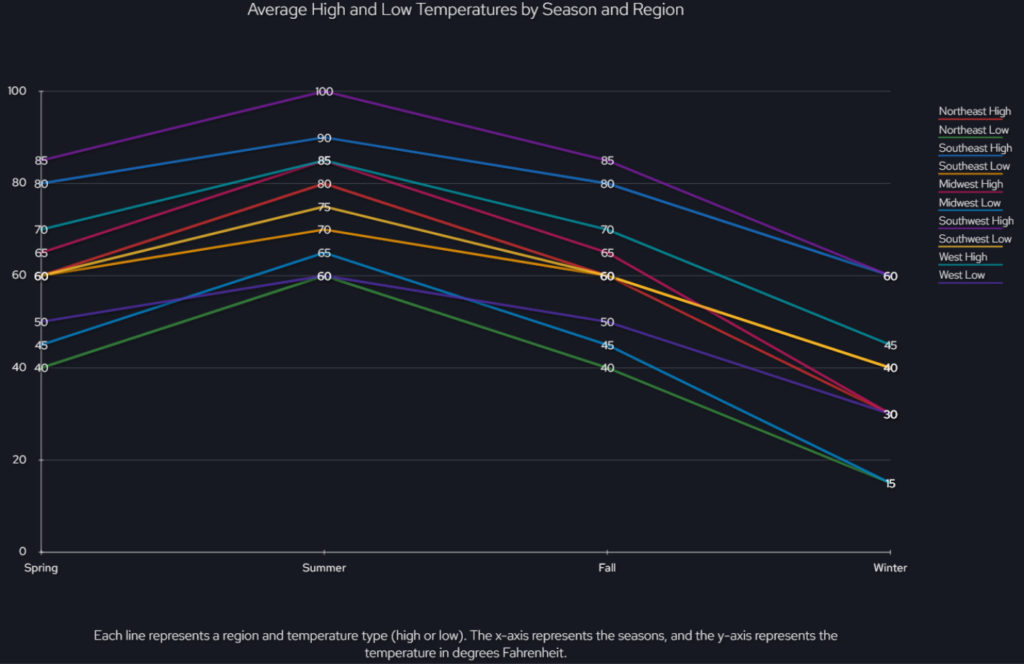
Average Precipitation by Season and Region
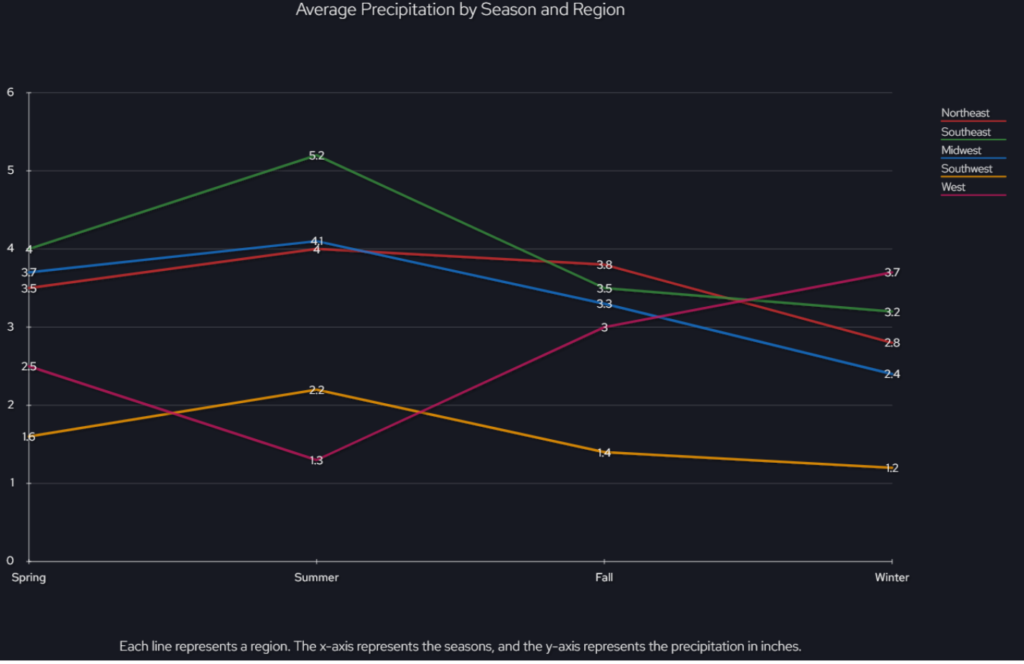
Average Hours of Daily Sunlight
| Region | Spring (hours) | Summer (hours) | Autumn (hours) | Winter (hours) |
|---|---|---|---|---|
| Northeast | 6-8 | 8-10 | 6-8 | 4-6 |
| Southeast | 8-10 | 10-12 | 8-10 | 6-8 |
| Midwest | 8-10 | 10-12 | 8-10 | 6-8 |
| Southwest | 10-12 | 12-14 | 10-12 | 8-10 |
| Northwest | 8-10 | 10-12 | 8-10 | 4-6 |
| West Coast | 10-12 | 12-14 | 10-12 | 6-8 |
| Rocky Mountains | 8-10 | 10-12 | 8-10 | 4-6 |
| Great Plains | 8-10 | 10-12 | 8-10 | 6-8 |
| Alaska | 6-8 | 8-10 | 6-8 | 4-6 |
| Hawaii | 10-12 | 12-14 | 10-12 | 8-10 |
Predict Future Changes:
Climate change is causing shifts in weather patterns. Try to stay informed about predictions for your area. For example, if hotter, drier summers are expected, you might prioritize drought-tolerant plants.
Observe Your Garden:
Finally, remember that your garden itself can provide valuable climate clues. For example, areas that are often waterlogged after rain might not be suitable for plants that prefer well-drained soil.
By assessing your local climate, you can make informed decisions that increase your garden’s resilience to weather extremes. In the next section, we’ll look at how to choose climate-resilient plants based on this information.
Choosing Climate-Resilient Plants
Choosing the right plants is a critical step in creating a climate-resilient garden. Here are some factors to consider:
Native Plants:
Native plants are often a great choice for climate-resilient gardens. They’re adapted to the local climate and soil conditions, and they provide habitat for local wildlife. Research what plants are native to your area and consider incorporating them into your garden.
Here are some tables of native plants that can be planted in home gardens for different regions. Please note that the regions mentioned below are general categories, and specific climate conditions may vary within each region. It’s always a good idea to consult local gardening resources or nurseries to find the most suitable native plants for your specific location.
Midwestern United States
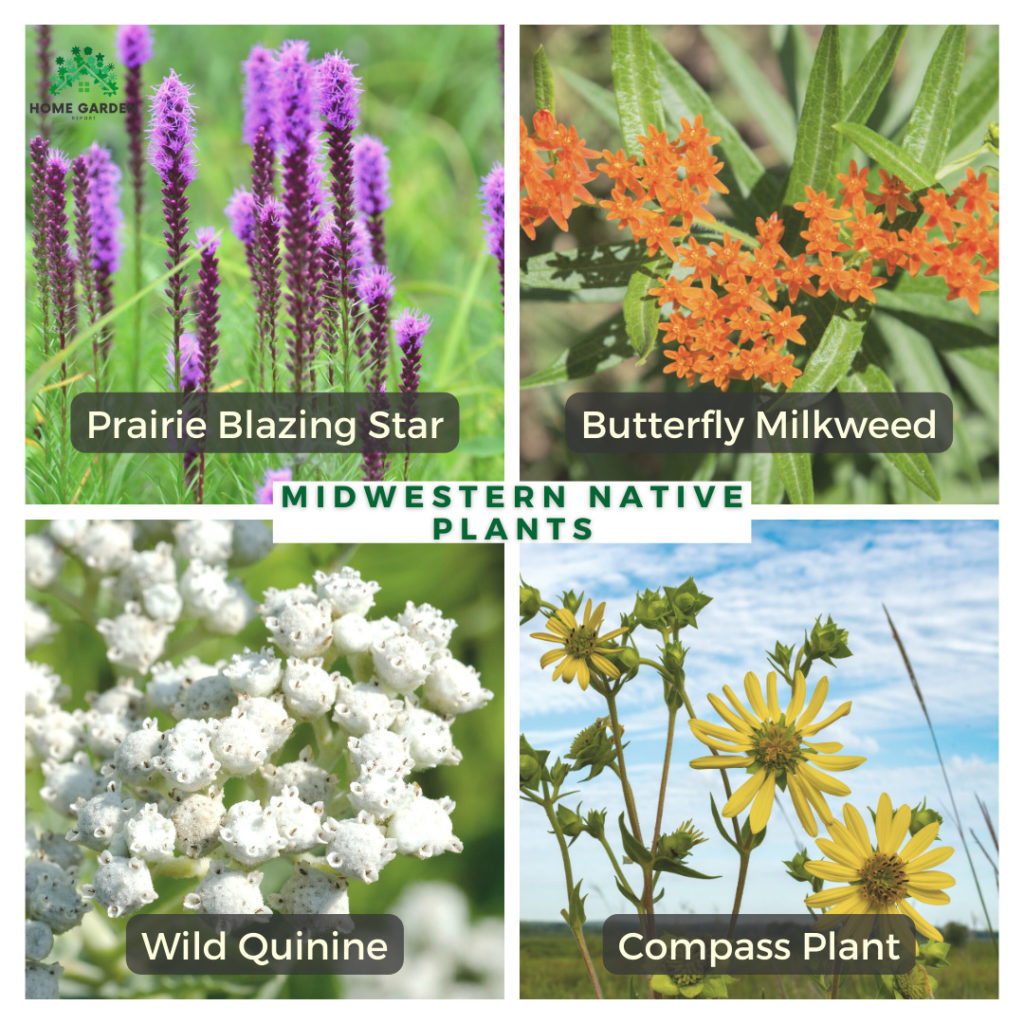
| Plant Name | Scientific Name |
|---|---|
| Purple Prairie Clover | Dalea purpurea |
| Leadplant | Amorpha canescens |
| Wild Bergamot | Monarda fistulosa |
| Compass Plant | Silphium laciniatum |
| Joe-Pye Weed | Eutrochium purpureum |
| Black-eyed Susan | Rudbeckia hirta |
| Prairie Blazing Star | Liatris pycnostachya |
| Wild Quinine | Parthenium integrifolium |
| Butterfly Milkweed | Asclepias tuberosa |
| Tall Coreopsis | Coreopsis tripteris |
Northeastern United States
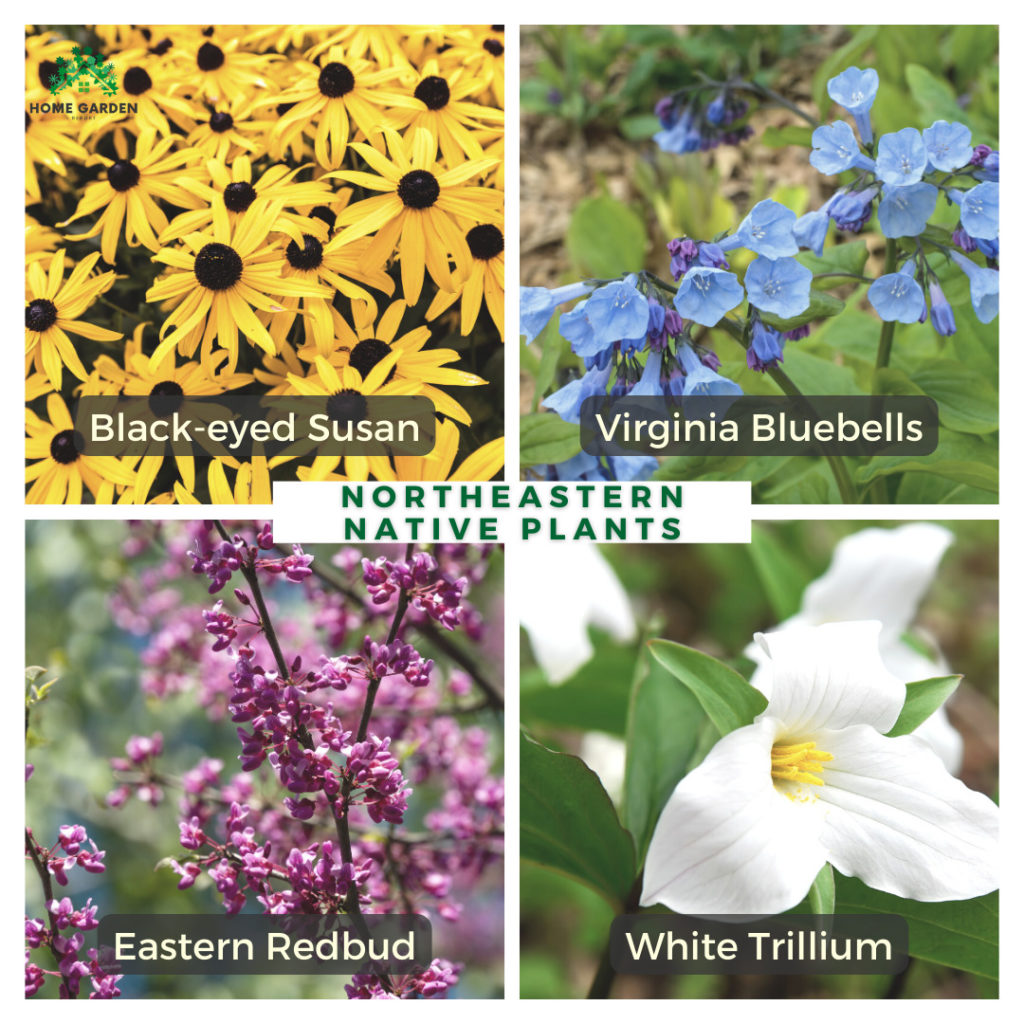
| Plant Name | Scientific Name |
|---|---|
| Eastern Redbud | Cercis canadensis |
| New England Aster | Symphyotrichum novae-angliae |
| Virginia Bluebells | Mertensia virginica |
| Black-eyed Susan | Rudbeckia hirta |
| White Trillium | Trillium grandiflorum |
| Northern Bayberry | Myrica pensylvanica |
| Eastern Red Columbine | Aquilegia canadensis |
| American Hazelnut | Corylus americana |
| Spicebush | Lindera benzoin |
| Wintergreen | Gaultheria procumbens |
Western United States
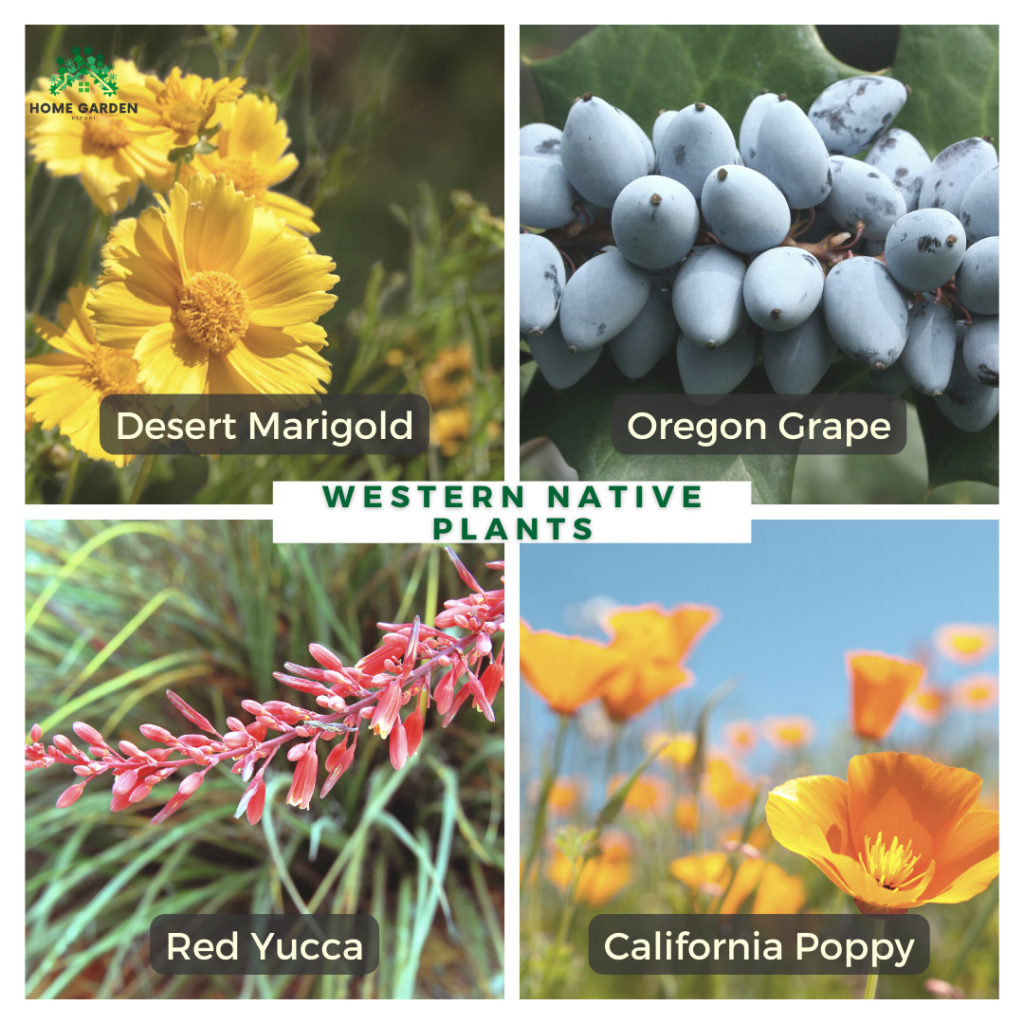
| Plant Name | Scientific Name |
|---|---|
| California Poppy | Eschscholzia californica |
| Pacific Coast Iris | Iris douglasiana |
| Douglas Fir | Pseudotsuga menziesii |
| Western Redbud | Cercis occidentalis |
| Desert Marigold | Baileya multiradiata |
| Red Yucca | Hesperaloe parviflora |
| Bigleaf Maple | Acer macrophyllum |
| Western Red Cedar | Thuja plicata |
| Oregon Grape | Mahonia aquifolium |
| Manzanita | Arctostaphylos spp. |
Southern United States
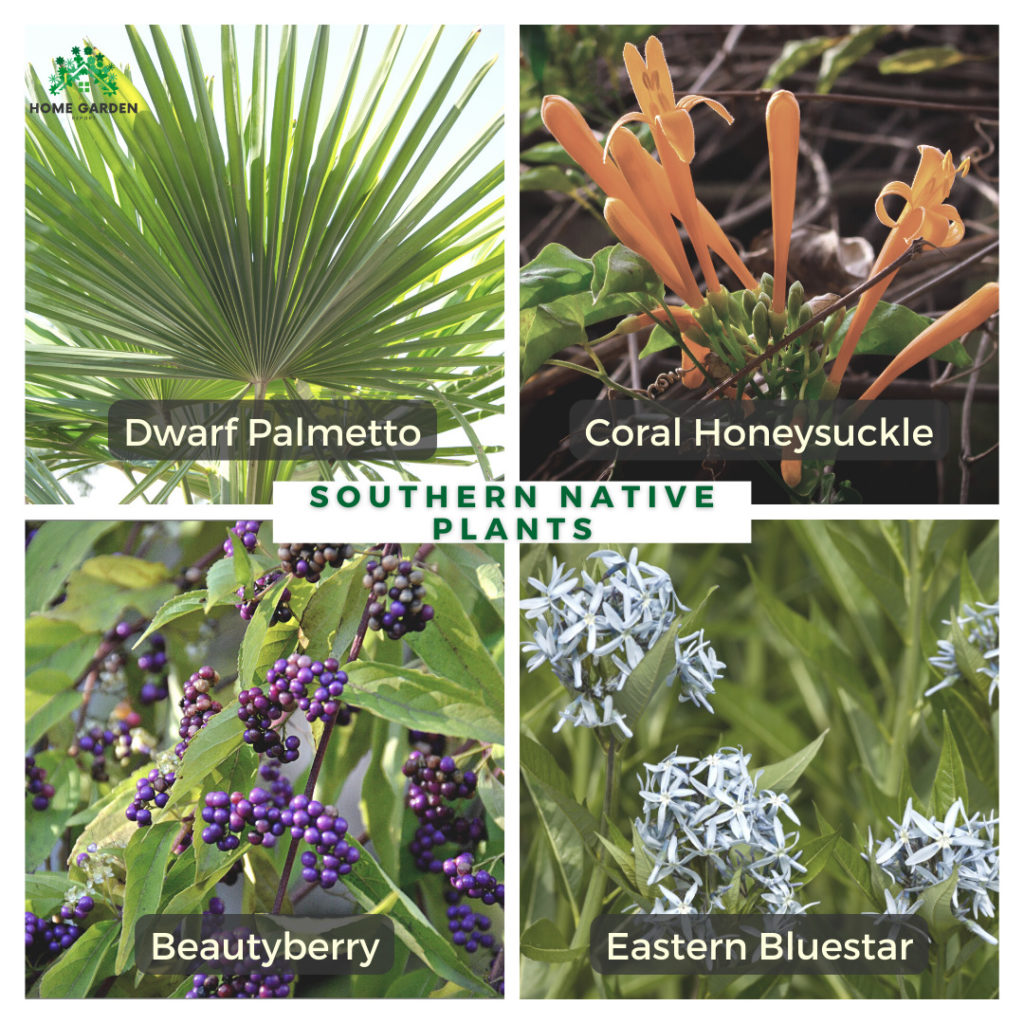
| Plant Name | Scientific Name |
|---|---|
| Carolina Jessamine | Gelsemium sempervirens |
| Coral Honeysuckle | Lonicera sempervirens |
| Purple Coneflower | Echinacea purpurea |
| Dwarf Palmetto | Sabal minor |
| Cardinal Flower | Lobelia cardinalis |
| Beautyberry | Callicarpa americana |
| Oakleaf Hydrangea | Hydrangea quercifolia |
| American Holly | Ilex opaca |
| Eastern Bluestar | Amsonia tabernaemontana |
| Yellow Jessamine | Gelsemium rankinii |
Please keep in mind that this is just a small selection of native plants for each region. There are many more options available, and it’s always a good idea to research and
Drought-Tolerant Plants:

If your area is prone to drought, consider plants that can survive with little water. Succulents, certain grasses, and many Mediterranean herbs fall into this category.
Here’s a table of drought-tolerant plants that can be planted in home gardens. These plants are adapted to thrive in regions with limited water availability and can withstand dry conditions.
Drought-Tolerant Plants
| Plant Name | Scientific Name |
|---|---|
| Agave | Agave spp. |
| Yucca | Yucca spp. |
| Lavender | Lavandula spp. |
| Russian Sage | Perovskia atriplicifolia |
| Red Hot Poker | Kniphofia uvaria |
| Sedum | Sedum spp. |
| Black-eyed Susan | Rudbeckia hirta |
| Kangaroo Paw | Anigozanthos spp. |
| Lantana | Lantana camara |
| Mexican Feather Grass | Nassella tenuissima |
| California Lilac | Ceanothus spp. |
| Rosemary | Rosmarinus officinalis |
| Cacti | Various species |
| Succulents | Various species |
| Texas Sage | Leucophyllum frutescens |
| Agastache | Agastache spp. |
| Penstemon | Penstemon spp. |
| Butterfly Bush | Buddleja spp. |
| Texas Red Yucca | Hesperaloe parviflora |
| Firewheel | Gaillardia pulchella |
| Verbena | Verbena spp. |
These plants have developed various mechanisms to store water and tolerate dry conditions. However, it’s important to note that even drought-tolerant plants require regular watering during their establishment period. Once established, they can thrive with reduced water inputs. Additionally, it’s advisable to check the specific water needs and growing conditions of each plant before incorporating them into your garden.
Cold-Hardy Plants:

If your area experiences cold winters, choose plants that can withstand freezing temperatures. Many perennial plants, shrubs, and trees are cold-hardy.
Here’s a table of cold-hardy plants that can be planted in home gardens. These plants are adapted to withstand cold temperatures and can thrive in regions with frost and freezing conditions.
Cold-Hardy Plants
| Plant Name | Scientific Name |
|---|---|
| Siberian Iris | Iris sibirica |
| Japanese Maple | Acer palmatum |
| Norway Spruce | Picea abies |
| Eastern Red Cedar | Juniperus virginiana |
| Winterberry Holly | Ilex verticillata |
| Purple Coneflower | Echinacea purpurea |
| Russian Sage | Perovskia atriplicifolia |
| Creeping Phlox | Phlox subulata |
| Red Twig Dogwood | Cornus sericea |
| Russian Olive | Elaeagnus angustifolia |
| Boxwood | Buxus spp. |
| Burning Bush | Euonymus alatus |
| Japanese Spirea | Spiraea japonica |
| Barberry | Berberis spp. |
| Virginia Creeper | Parthenocissus quinquefolia |
| Old Fashion Snowball | Viburnum opulus |
| Witch Hazel | Hamamelis spp. |
| Japanese Andromeda | Pieris japonica |
| Siberian Spruce | Picea obovata |
| Blue Spruce | Picea pungens |
| Arctic Willow | Salix arctica |
These plants are known for their ability to tolerate and even thrive in cold climates. However, it’s important to note that the specific cold-hardiness of a plant may vary depending on the cultivar and the severity of the winter conditions in your region. It’s advisable to choose plant varieties that are recommended for your specific hardiness zone and to provide proper winter protection, such as mulching or covering, for newly planted or more sensitive plants.
Heat-Tolerant Plants:

In areas with hot summers, heat-tolerant plants are essential. These plants can survive high temperatures and often have features like thick leaves or deep roots to conserve water.
Here’s a table of heat-tolerant plants that can be planted in home gardens. These plants are adapted to withstand high temperatures and thrive in regions with hot and dry climates.
Heat-Tolerant Plants
| Plant Name | Scientific Name |
|---|---|
| Lantana | Lantana camara |
| Bougainvillea | Bougainvillea spp. |
| Agave | Agave spp. |
| Red Yucca | Hesperaloe parviflora |
| Portulaca | Portulaca grandiflora |
| Mexican Sunflower | Tithonia diversifolia |
| Texas Sage | Leucophyllum frutescens |
| Desert Marigold | Baileya multiradiata |
| Purple Fountain Grass | Pennisetum setaceum ‘Rubrum’ |
| Kangaroo Paw | Anigozanthos spp. |
| Zinnia | Zinnia spp. |
| Canna Lily | Canna spp. |
| Salvia | Salvia spp. |
| Yucca | Yucca spp. |
| Blanket Flower | Gaillardia spp. |
| Penstemon | Penstemon spp. |
| Verbena | Verbena spp. |
| Black-eyed Susan | Rudbeckia hirta |
| Rosemary | Rosmarinus officinalis |
| Sedum | Sedum spp. |
| Geranium | Pelargonium spp. |
These heat-tolerant plants have adapted mechanisms to withstand high temperatures, intense sunlight, and dry conditions. However, it’s important to note that while these plants can tolerate heat, they still require adequate watering during periods of drought and may benefit from mulching to conserve soil moisture. Additionally, it’s advisable to choose plant varieties that are recommended for your specific climate zone to ensure their optimal growth and resilience to heat stress.
Flood-Resistant Plants:
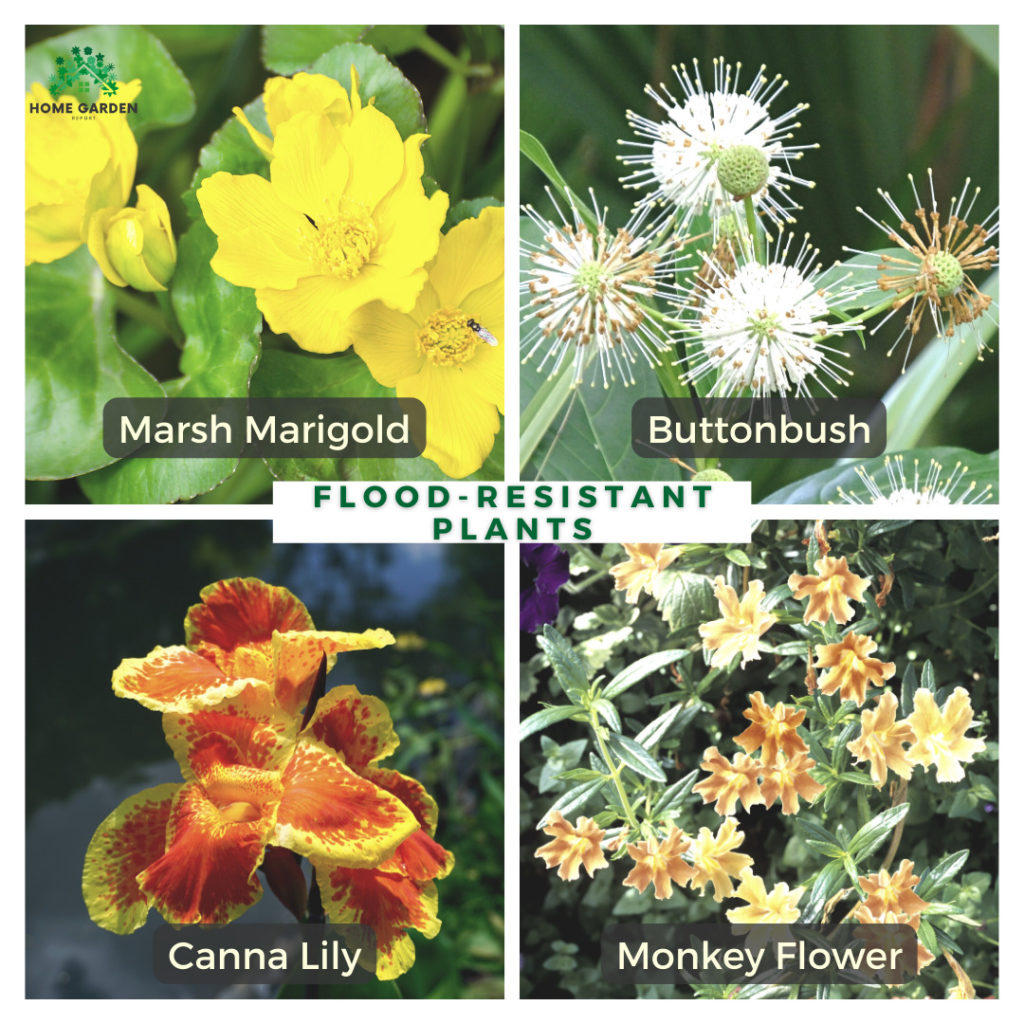
If your garden is prone to flooding, consider plants that can withstand waterlogged soil. Many wetland plants fall into this category.
Here’s a table of flood-resistant plants that can be planted in home gardens. These plants are adapted to withstand periods of excessive moisture and can thrive in regions prone to flooding or areas with poor drainage.
Flood-Resistant Plants
| Plant Name | Scientific Name |
|---|---|
| Bald Cypress | Taxodium distichum |
| Marsh Marigold | Caltha palustris |
| Cardinal Flower | Lobelia cardinalis |
| Switchgrass | Panicum virgatum |
| Joe-Pye Weed | Eutrochium spp. |
| Siberian Iris | Iris sibirica |
| Swamp Milkweed | Asclepias incarnata |
| Canna Lily | Canna spp. |
| Buttonbush | Cephalanthus occidentalis |
| Blue Flag Iris | Iris versicolor |
| Virginia Bluebells | Mertensia virginica |
| Japanese Primrose | Primula japonica |
| Horsetail | Equisetum spp. |
| Sweet Flag | Acorus calamus |
| Monkey Flower | Mimulus spp. |
| Water Iris | Iris pseudacorus |
| Turtlehead | Chelone spp. |
| Royal Fern | Osmunda regalis |
| Water Hyacinth | Eichhornia crassipes |
| Water Lettuce | Pistia stratiotes |
These flood-resistant plants have adapted to thrive in wet or waterlogged conditions. They can withstand periods of flooding and excessive moisture, making them suitable for gardens located in flood-prone areas or sites with poor drainage. However, it’s important to note that while these plants can tolerate wet conditions, prolonged flooding or standing water can be detrimental to most plants. Adequate drainage and soil management practices should be implemented to maintain plant health and prevent waterlogging-related issues.
Remember, diversity is key in a resilient garden. A mix of plants with different characteristics can help your garden withstand a range of weather conditions. And don’t forget to consider the needs of each plant, including sunlight, soil type, and space requirements.
In the next section, we’ll discuss how to conserve water in your garden, a key aspect of climate-resilient gardening.
[Image: A collage of different types of climate-resilient plants, such as a succulent (drought-tolerant), a fern (flood-resistant), and a native wildflower]
Implementing Water-Smart Practices
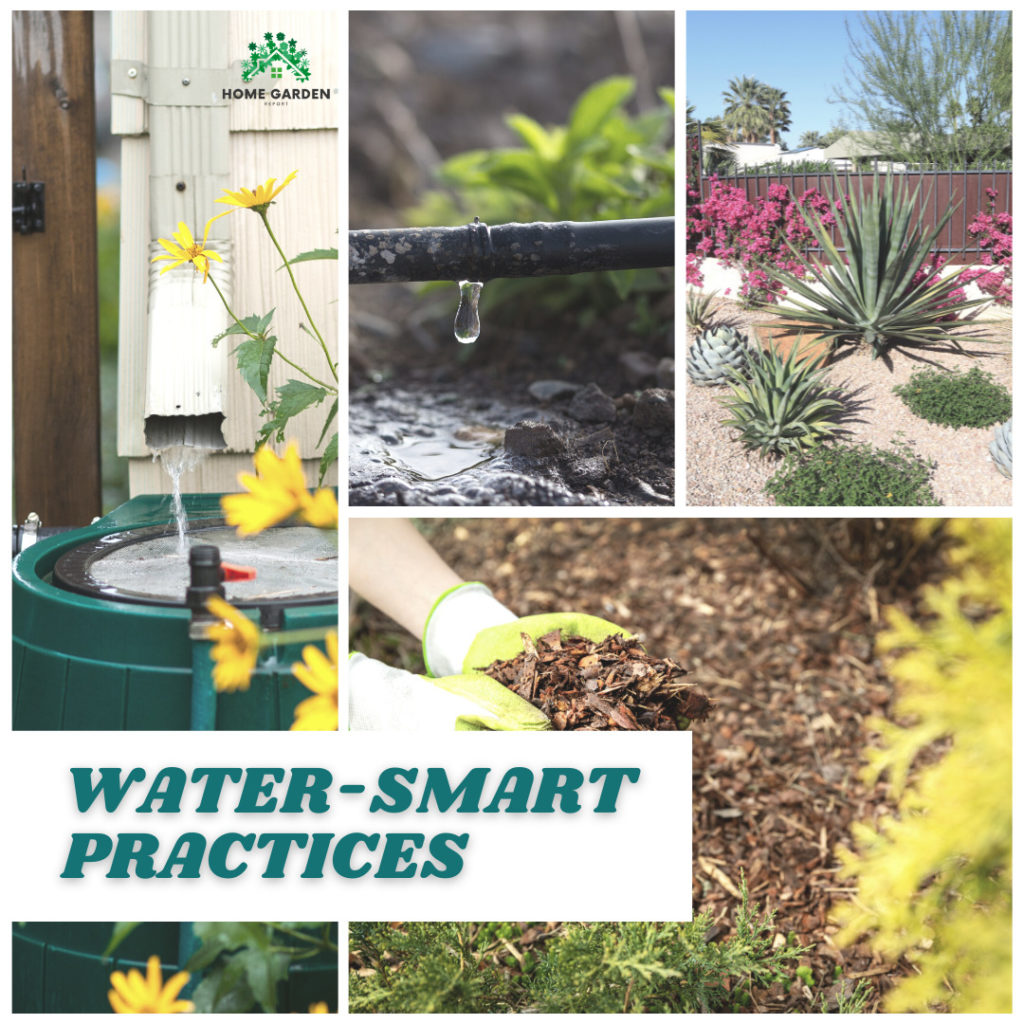
Water is a precious resource, and conserving it is a key aspect of climate-resilient gardening. Here are some water-smart practices you can implement in your garden:
1. Watering at the Right Time:
Watering early in the morning or late in the evening reduces evaporation, allowing more water to reach your plants’ roots. Avoid watering in the heat of the day when much of the water would evaporate before reaching the soil.
2. Using Efficient Watering Methods:
Drip irrigation and soaker hoses deliver water directly to the base of your plants, reducing evaporation. These methods are more efficient than overhead sprinklers, which can lose a lot of water to evaporation and wind.
3. Mulching:
Mulch is a layer of organic material applied to the surface of your soil. It helps conserve moisture, reduce weed growth, and improve soil health. Mulch can be made from a variety of materials, including compost, shredded leaves, or straw.
4. Collecting Rainwater:
Rain barrels can be used to collect rainwater from your roof, which can then be used to water your garden. This not only conserves water but also reduces your water bill.
5. Planting in Groups:
Grouping plants with similar water needs together can make watering more efficient and help prevent over-watering or under-watering.
By implementing these water-smart practices, you can help your garden thrive while conserving water and contributing to a more sustainable future.
Building Healthy Soil
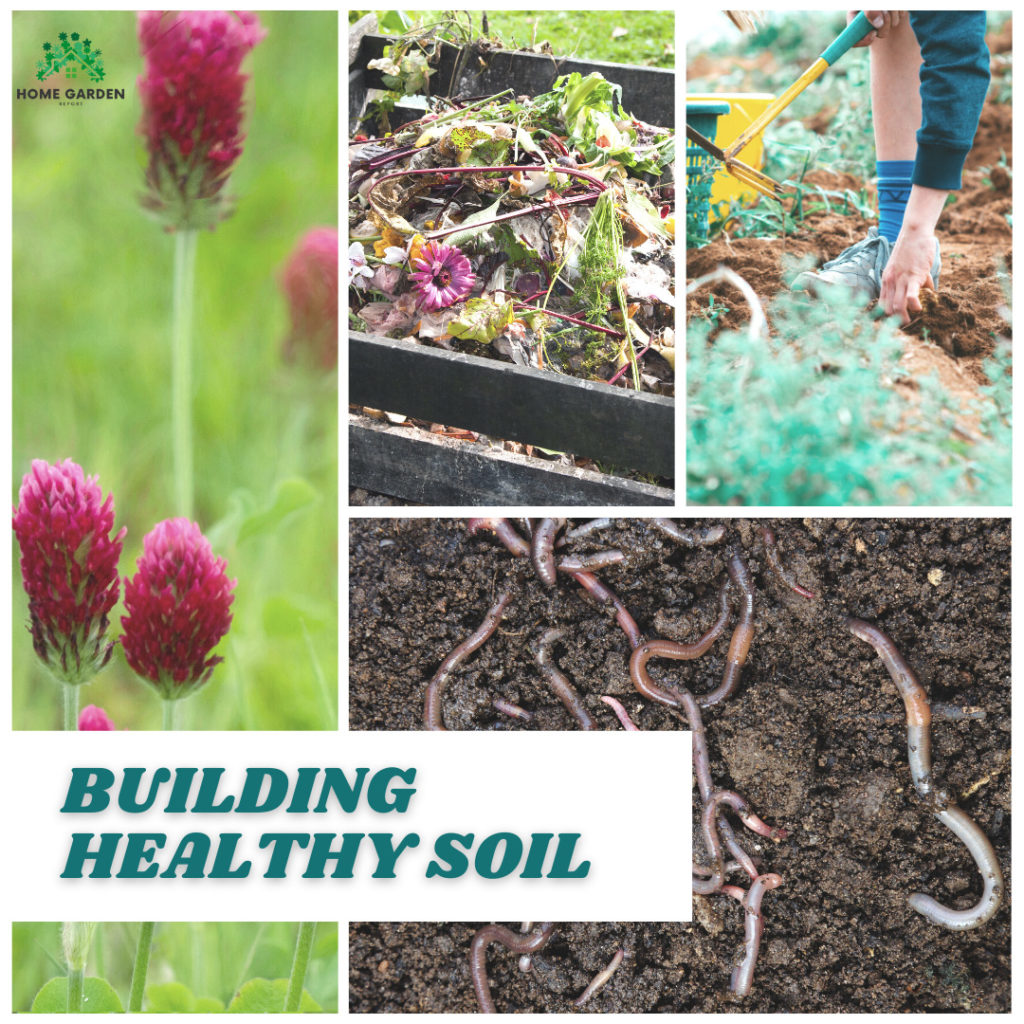
Healthy soil is the foundation of a thriving, climate-resilient garden. It supports plant growth, stores water, and helps mitigate climate change by storing carbon. Here’s how to build healthy soil in your garden:
1. Composting:
Composting is a process that turns organic waste, like kitchen scraps and yard waste, into nutrient-rich soil conditioner. It improves soil fertility, helps soil retain moisture, and reduces the need for chemical fertilizers. Starting a compost pile or bin in your backyard is a simple way to create your own compost.
2. Cover Cropping:
Cover crops are plants grown to improve soil health. They prevent soil erosion, improve soil structure, and can add nutrients to the soil. Examples of cover crops include clover, vetch, and rye.
3. No-Till Gardening:
Traditional gardening often involves tilling, or turning over the soil. However, this can disrupt soil structure and harm beneficial soil organisms. No-till gardening involves leaving the soil undisturbed, which helps maintain healthy soil structure and biodiversity.
4. Organic Mulching:
As we mentioned earlier, mulching helps conserve soil moisture. Organic mulches, like compost, leaves, or straw, also improve soil fertility as they break down.
5. Regular Soil Testing:
Regular soil testing can help you understand your soil’s nutrient levels and pH, allowing you to make adjustments as needed to support plant health.
By focusing on building healthy soil, you can create a garden that’s more resilient to climate change and more productive.
Encouraging Biodiversity
Biodiversity is a key component of a climate-resilient garden. A diverse garden is more resilient to pests, diseases, and climate extremes, and it provides important habitat for local wildlife. Here’s how you can encourage biodiversity in your garden:

1. Plant a Variety of Species:
Planting a mix of different species creates a more diverse habitat and can help attract a range of wildlife. Try to include a mix of trees, shrubs, flowers, and grasses.
2. Create Habitats:
Consider adding features like a pond, log pile, or birdhouse to provide habitat for wildlife. Even a small pond can attract a variety of insects, amphibians, and birds.
3. Plant Native Species:
Native plants provide food and habitat for local wildlife and are adapted to your local climate and soil conditions.
4. Avoid Chemical Pesticides:
Chemical pesticides can harm beneficial insects and other wildlife. Try using organic pest control methods instead, like encouraging beneficial insects or using natural pest repellents.
5. Leave Some Areas Wild:
Consider leaving some areas of your garden a little wild to provide habitat for wildlife. This could be a corner of your garden with long grass and wildflowers, for example.
By encouraging biodiversity, you can create a garden that’s not only beautiful and productive, but also supports local ecosystems and contributes to a healthier planet.
Conclusion
As we’ve explored in this post, creating a climate-resilient garden is a multifaceted process that involves understanding your local climate, choosing the right plants, implementing water-smart practices, building healthy soil, and encouraging biodiversity. It’s about creating a garden that not only withstands the challenges of climate change but also contributes to a healthier planet.
While the task may seem daunting, remember that every small step counts. Even implementing just one of the strategies we’ve discussed can make a difference. And the rewards – a thriving garden, a healthier local ecosystem, and the knowledge that you’re contributing to a more sustainable future – are well worth the effort.
In the face of climate change, the future of gardening is green in more ways than one. By embracing climate-resilient gardening practices, we can ensure that our gardens not only survive but thrive, no matter what the future holds.
As we conclude, we invite you to take the first step towards creating a climate-resilient garden. Whether it’s doing some research on your local climate, starting a compost pile, or planting a native tree, there’s no better time to start than now.
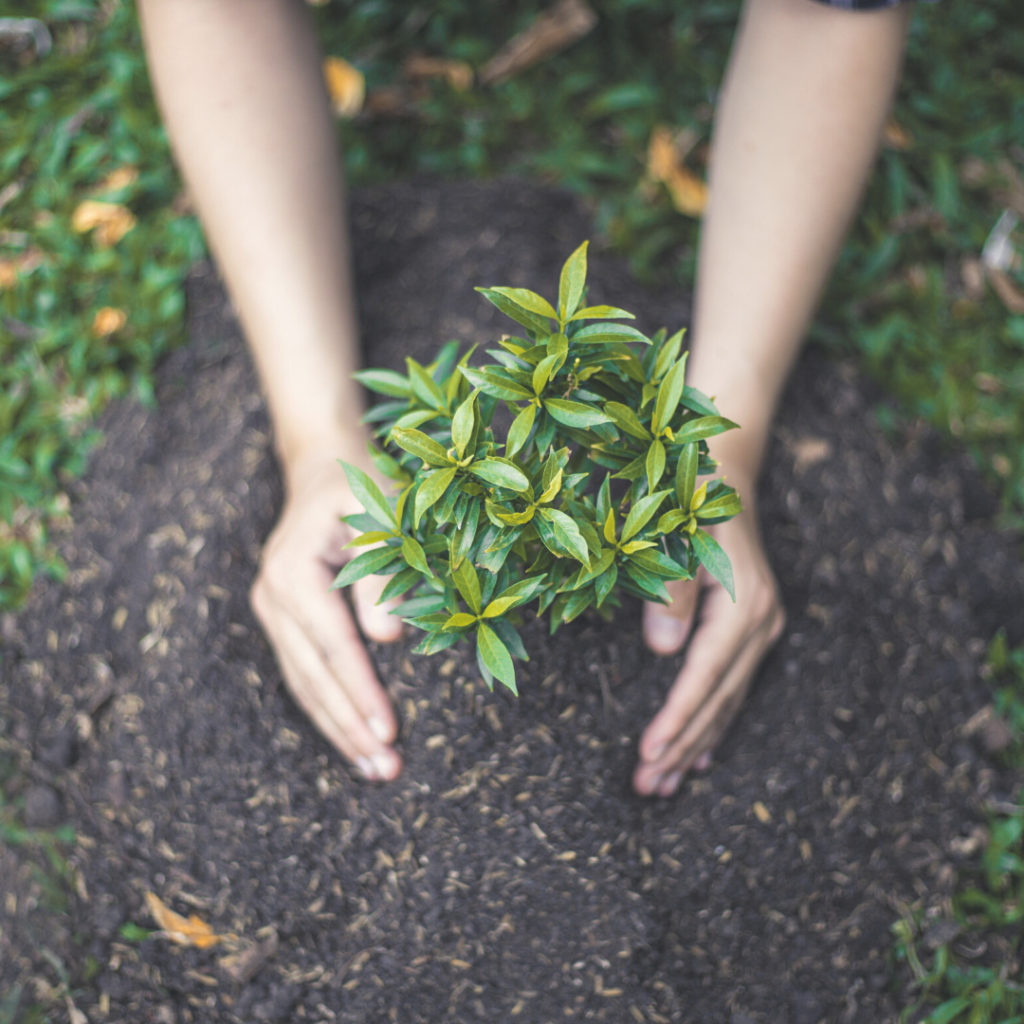
Call to Action
We hope this guide has inspired you to start your journey towards creating a climate-resilient garden. As you embark on this journey, we’d love to hear about your experiences. What challenges have you faced? What successes have you celebrated? Your stories can inspire and guide others who are also striving to create climate-resilient gardens.
Remember, every garden is unique, and every gardener has something valuable to share. So, let’s learn from each other and grow together.
Don’t forget to subscribe to our blog for more gardening tips and advice, and join our community of gardeners who are making a difference. Let’s create a greener future, one garden at a time.



